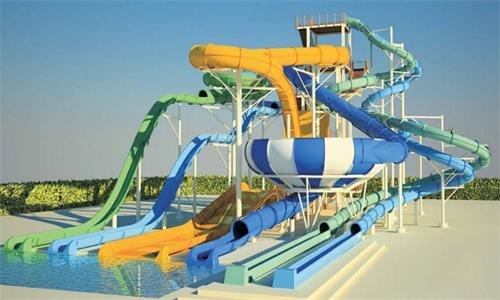2025 Water Park Feasibility Study Report
- Based on a Chinese Project
Excerpt
A water park is an amusement park that features water play areas, such as swimming pools, water slides, splash pads, spray grounds (water playgrounds), lazy rivers, or other recreational bathing, swimming, and barefooting environments.
Water parks in more current states of development may also be equipped with some type of artificial surfing or body boarding environment such as a wave pool or Flow Rider.
Now the water park is the good idea of amusement. It is very good assets created by human being to enjoy the natural scenery artificially, if situated near by forest or hilly area. Amusement water parks generally feature a few water rides, such as the log flume, bumper boats, and rowing boats. Such rides are usually gentler and shorter than roller coasters and many are suitable for all ages.
Water rides are especially popular on hot days. Amusement water parks generally feature a few water rides, such as the log flume, bumper boats, and rowing boats. Such rides are usually gentler and shorter than roller coasters and many are suitable for all ages. Water rides are especially popular on hot days. The industry can be broadly categorised into amusement parks, theme parks and water parks. The sector can also be broadly segmented on the basis of the catchment area that they cater to, along with the type and scale of activities they offer.
Global amusement parks can also be classified on the basis of the concepts and themes around which a park/ offering is designed such as thrill & adventure, sports & edutainment, amongst a few. Every year the industry is seeing 15-20 percent growth in the sector – be it expansion of existing parks or the setting up of new ones. The Industry has been growing at a compounded annual growth rate (CAGR) of more than 17.5 percent with annual revenue of approx.Sixty-six percent of the population is below 35 years, with the median age of 27 years driving consumption. Younger consumers have high spending power and are open to experiment with newer places and forms of entertainment.
The water park industry has shown continued growth in 2014 with increased numbers of indoor and outdoor water parks being developed throughout the United States and Canada. Our projections for 2022 show a number of new openings will occur throughout North America, which will boost the supply of water parks and increase revenues for this growing industry. There are over 800 amusement parks worldwide with annual attendance of over 700m visitors. The US alone has 50% of the parks and annual visitors. Europe has ~330 amusement parks with annual visits of 165m. Parks in the US and Europe are near maturity levels, whereas Asia has seen rapid growth in visitors in the last seven years.
KeyWord
- How to open water park
- What cost of building a water park
- How much money does a water park make in a year
Specification
This document is helpful to guide how to start a water park and give you an idea of how much it costs for a whole project. It is based on a project in China and provides detailed digits.
Tags
Water Amusement Park,How To Open Water Park Detailed Project Report, Profile,Business Plan, Industry Trends, Market Research, Survey, Machinery, Raw Materials, Feasibility Study, Investment Opportunities, Cost And Revenue,Plant Economics
Useful Table
Total Cost Estimation Table
Park Construction cost / budget
Area method predicts the carrying capacity of visitors
Composition table of construction investment
Project implementation schedule
Table of labor personnel
List of main technical and economic indicator
Index
Park Construction cost / budget 2
Area method predicts the carrying capacity of visitors 2
Composition table of construction investment 2
Project implementation schedule 2
List of main technical and economic indicator 2
Chapter 1
Project Brief Introduction 6
1.4.2 Construction address and construction period 6
2.Project construction period 6
Chapter 4
Market Analysis and Prediction 8
4.3 Target market positioning 9
4.4 Marketing strategies, solutions, and marketing models 9
4.4.1 lifecycle marketing strategy 9
3.Long-term stability period 10
4.4.2 Recent Promotion Strategy 10
Chapter 5
Overall Planning and Construction Scale 12
5.2 Planning the general layout 12
5.6 Greening system planning 15
(1) The principle of adapting measures to local conditions and adapting to trees 15
(2) Combination of fast-growing tree species and slow-growing tree species 15
(3) The principle of plant diversity 15
(4) Principles for selecting flowers and plants 15
Chapter 6
Project Construction Plan 16
(1) Comprehensive reception area 16
Ecological Farm in Gangkou Small Fishing Village 18
(3) Recreation area on land 23
6.1.7 Main structural materials 24
6.1.8 Purchase of main equipment 24
- The principle of equipment selection 24
- Equipment selection 24
- water-supply system 25
- Drainage design 26
- Sewage system 27
- Rainwater system 28
- Fire fighting system 28
- Power Engineering 29
Chapter 10
Organizational Structure and Labor Quota 37
Chapter 11
Project Implementation Progress and Bidding 40
11.1 Project implementation progress 40
Chapter 12
Investment Estimates and Sources of Funds 41
12.1 Construction investment estimation 41
12.1.1 Scope of construction investment estimation 41
12.1.3 Construction investment estimation 41
12.1.4 Analysis of construction investment composition 41
12.3 Estimation of working capital 41
12.4 Total investment estimation 42
Chapter 13
Financial Evaluation 43
13.2 Business income and tax calculation 43
13.2.1 Calculation of operating income 43
13.2.2 Sales tax and surcharges 44
13.3.1 Basic operating costs 44
13.3.2 Wages and surcharges 45
13.3.5 Amortization of intangible and other assets 45
13.3.8 Analysis of Total Cost Composition 46
13.7 Project risk analysis and risk avoidance 47
13.7.1 Identification of main risk factors 47

